Home>About River Restoration>Best Management Practices>SBEinfo
Streambank Stabilization Best Management Practices
Eroding streambanks on northern Michigan streams can be caused by a variety of changes to the stream:
Why do river banks erode?
- Historical logging practices from the 1800s during which forests along rivers were clear-cut, steep banks were used as log rollaways, and streams were used to transport logs to sawmills, railroads, and Lake Michigan.
- Heavy recreational use
- Development
- Lawn mowing & vegetation removal close to a river’s edge
- Improper livestock management and agricultural use within a river corridor
- Improper placement of or removal of woody debris can change stream dynamics, pushing water currents towards sensitive bank areas
- Dams, floods and other manipulations of or changes to stream flows
How to stabilize an eroding bank?
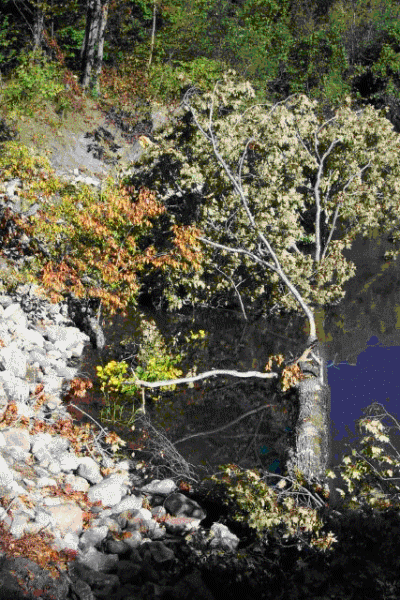
- Place fieldstone along the base of the bank, a couple feet above the high water mark
- If a bank is low and the water is shallow, coir logs (made of coconut fibers) can be staked along the base of the bank.
- If a bank is high, logs can be “terraced” along the upper slope to prevent sand from continuously sliding down.
- Plant trees and shrubs. Recommended tree species for sandy soils include white pine, white spruce, jack pine, and red pine. Shrubs include willow, red osier dogwood, silky dogwood at the base of banks and service berry, sumac, gray dogwood along the upper slopes.
- Whole trees or large woody debris (LWD) can be cabled and/or posted along the base of a bank in front of rock to help divert a strong current from hitting a sensitive bank while also providing fish cover and wildlife resting spots.
- Install platform structures made of untreated oak under the fieldstone to provide fish and wildlife with hiding and resting cover.
Streambank Site “Before”:
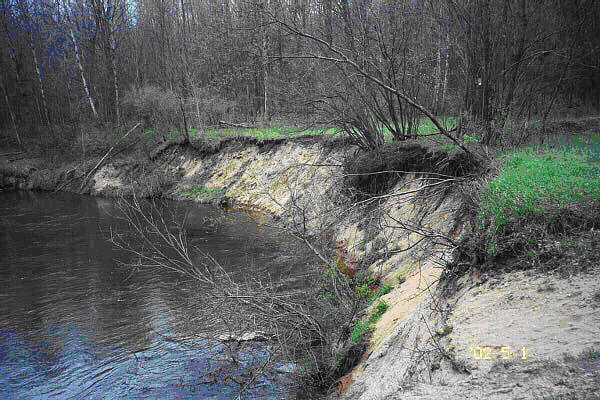 This severely eroding streambank was dumping tons of sand into the Betsie River every year. The steep, sandy conditions prevented the bank from revegetating on its own.
This severely eroding streambank was dumping tons of sand into the Betsie River every year. The steep, sandy conditions prevented the bank from revegetating on its own.
 This severely eroding streambank was dumping tons of sand into the Betsie River every year. The steep, sandy conditions prevented the bank from revegetating on its own.
This severely eroding streambank was dumping tons of sand into the Betsie River every year. The steep, sandy conditions prevented the bank from revegetating on its own.Streambank Site After 3 Years:
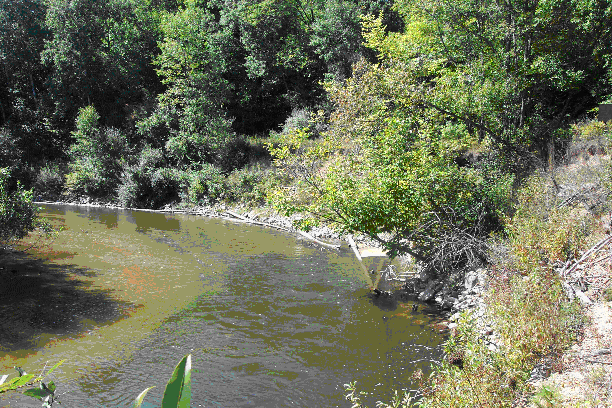 Over 200 cu. yds. of fieldstone was placed along the toe of the bank, log terraces were installed along the upper slope, seedlings were planted, and woody debris was placed in the stream in front of the rock for fish cover.
Over 200 cu. yds. of fieldstone was placed along the toe of the bank, log terraces were installed along the upper slope, seedlings were planted, and woody debris was placed in the stream in front of the rock for fish cover.
 Over 200 cu. yds. of fieldstone was placed along the toe of the bank, log terraces were installed along the upper slope, seedlings were planted, and woody debris was placed in the stream in front of the rock for fish cover.
Over 200 cu. yds. of fieldstone was placed along the toe of the bank, log terraces were installed along the upper slope, seedlings were planted, and woody debris was placed in the stream in front of the rock for fish cover.Log Terracing:
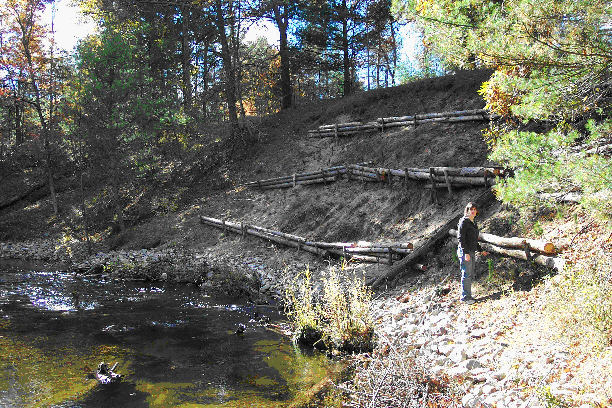 Log terracing is where logs are staked in along steep slopes to prevent sand from sliding down the bank. Trees & shrubs are planted behind them.
Log terracing is where logs are staked in along steep slopes to prevent sand from sliding down the bank. Trees & shrubs are planted behind them.
 Log terracing is where logs are staked in along steep slopes to prevent sand from sliding down the bank. Trees & shrubs are planted behind them.
Log terracing is where logs are staked in along steep slopes to prevent sand from sliding down the bank. Trees & shrubs are planted behind them."Natural Looking" Stream Bank:
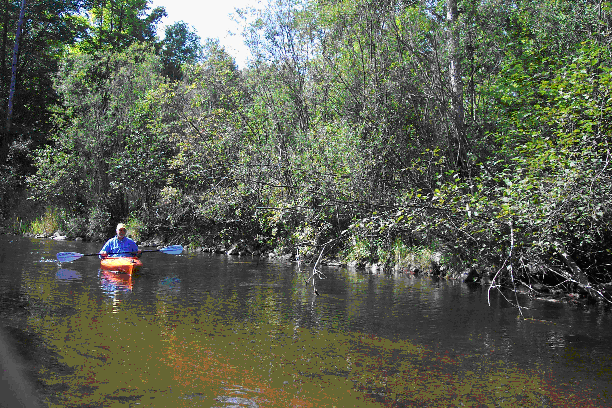 A streambank 15 years after it was stabilized. The goal is for the bank to look natural over time.
A streambank 15 years after it was stabilized. The goal is for the bank to look natural over time.
 A streambank 15 years after it was stabilized. The goal is for the bank to look natural over time.
A streambank 15 years after it was stabilized. The goal is for the bank to look natural over time.Poor Agricultural Practices:
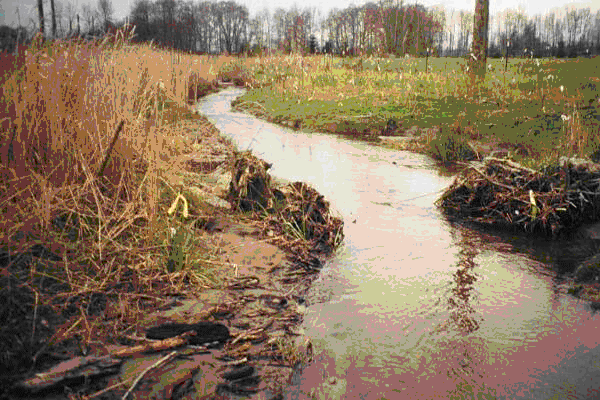 Improper agricultural and livestock management practices along streams can contribute sediment to waterways.
Improper agricultural and livestock management practices along streams can contribute sediment to waterways.
 Improper agricultural and livestock management practices along streams can contribute sediment to waterways.
Improper agricultural and livestock management practices along streams can contribute sediment to waterways.Good Agricultural Practices:
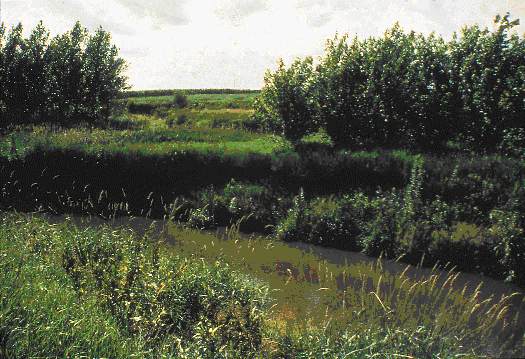 By maintaining a vegetative buffer along streams, impacts from farming can be minimized.
By maintaining a vegetative buffer along streams, impacts from farming can be minimized.Ideal River Bank Profile:
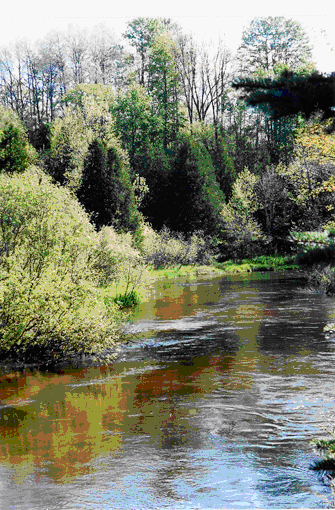 An ideal profile of a river includes different types of trees and shrubs that help shade the river and provide diverse fish and wildlife habitat.
An ideal profile of a river includes different types of trees and shrubs that help shade the river and provide diverse fish and wildlife habitat.Groomed Lawn to River Edge:
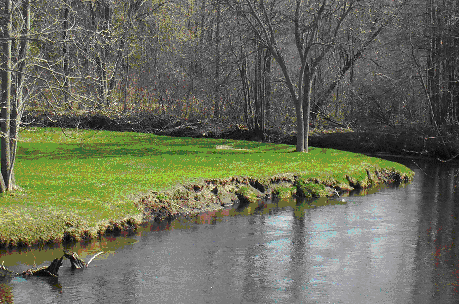 Mowing lawns to a river’s edge can cause slumping and erosion. It’s important to maintain a buffer of vegetation up to 10’ wide or more. Shrubs can be trimmed and pathways can be made to provide views of the river.
Mowing lawns to a river’s edge can cause slumping and erosion. It’s important to maintain a buffer of vegetation up to 10’ wide or more. Shrubs can be trimmed and pathways can be made to provide views of the river.
 Mowing lawns to a river’s edge can cause slumping and erosion. It’s important to maintain a buffer of vegetation up to 10’ wide or more. Shrubs can be trimmed and pathways can be made to provide views of the river.
Mowing lawns to a river’s edge can cause slumping and erosion. It’s important to maintain a buffer of vegetation up to 10’ wide or more. Shrubs can be trimmed and pathways can be made to provide views of the river.This page last updated on 12/13/2011.
